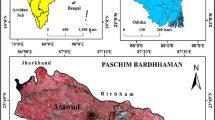Abstract
Wetlands are one of the most important sources of atmospheric methane (CH4) contributing about 22% to the global methane budget. But to improve estimates of CH4 emission at regional and global scales there is a need to observe the sources such as wetlands frequently and develop process-based models. In this regard, wetland inventory using satellite remote sensing data has conventionally been carried out by analysis of optical data. Due to thermal inertia differences emittive thermal channels data has shown promise to provide highly critical information about wetlands such as water spread, aquatic vegetation and mud flats etc. Thermal channels data of MODIS (Moderate Resolution Imaging Spectroradiometer) sensor with a spatial resolution of 1km and swath of 2330 km is emerging as the key source of remote sensing data for global/ regional wetland estimation and assessment of green house gas emission. In the present study MODIS thermal channels (31 and 32) and optical channels (1,2, and 3) data have been used for evaluating methane emission from wetlands in Gujarat. An empirical model based on temperature and productivity has been used to investigate the response of methane emission from different sources. Model has the potential to estimate country level methane emission based on satellite remote sensing in conjunction with collateral data/information. In this study. MODIS data of two dates pertaining to Gujarat have been analyzed and results compared with respect to methane emission.
Similar content being viewed by others
References
Agarwal, R., Garg, J.K. and Ajai. (2005). Land Surface Temperature (LST) mapping using MODIS data by Constant Emissivity Method and its utility in land surface delineation. MODIS Data Utilization Workshop, held at Space Applications Center (ISRO), Ahmedabad from April 19-20, 2005.
Cao, M., Marshell, S. and Gregson, K. (1996). Global carbon exchange and methane emissions from natural wetlands: Application of a process based model.Journal of Geophysical Research,101(14): 399–14,414.
Garg, J.K., Singh, T.S. and Murthy, T.V.R. (1998). Wetlands of India. Project Report: RSAM/SAC/ RESA/PR/01/98.239p.
IPCC (1998). The regional impacts of climate change: An assessment of vulnerability, Cambridge University Press.
Kahle, A.B. (1987). Surface emittance, temperature and thermal inertia derived from thermal infrared multispectral scanner (TIMS) data for Death Valley, California.Geophysics,52: 858–874.
Li, Z.L., Becker, F., Stoll, M.P. and Wan, Z. (1999). Evaluation of six methods for extracting relative emissivity spectra from thermal infrared images.Remote sensing of Environment,69: 197–214.
Liu, Y. (1996). Modelling the emission of nitrous oxide (N2O) and methane (CH4) from the Terrestrial biosphere to the atmosphere. MIT joint Program on the Science and Policy of Global Change, Report No. 10.
Matthews, E. and Fung, I. (1987). Methane emission from natural wetlands: Global distribution, area and environmental characteristics of sources.Global Biogeochemical Cycles,1: 61–86.
Sheppard, J.C., Westberg, H., Hopper, J.F., Ganesan, K., and Zimmerman, P. (1982). Inventory of global methane sources and their production rates.J. Geo. Res.,87: 1305–1312.
Walter, P. and Heimann, M. (2000). A Process based, climate sensitive model to derive methane emissions from natural wetlands: Application to five wetlands, sensitive to model parameters, and climate change.Global Biogeochemical Cycles 14: 745–765.
Walter, P., Heimann, M. and Matthews, E. (2001). Modeling modern methane emissions from natural wetlands 1. Model description and results.J. Geo. Res.,106:34, 189-34, 206.
Wan, Z. and Dozier,.J. (1996). A generalized split window algorithm for retrieving land surface temperature from space.IEEE Transactions on Geosciences and Remote Sensing,34: 892–905.
Wan, Z. (1997). A physics based algorithm for retrieving land surface emissivity and temperature from FOS/ MODIS data.IEEE Transactions on Geosciences and Remote Sensing,35: 980–996.
Watson, K. (1982). Spectral ratio method for measuring emissivity.Remote Sensing of Environment,42: 113–116.
Author information
Authors and Affiliations
Corresponding author
About this article
Cite this article
Agarwal, R., Garg, J.K. Methane emission modelling using MODIS thermal and optical data: A case study on Gujarat. J Indian Soc Remote Sens 35, 323–331 (2007). https://doi.org/10.1007/BF02990788
Received:
Revised:
Issue Date:
DOI: https://doi.org/10.1007/BF02990788




